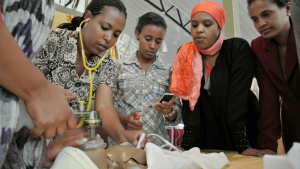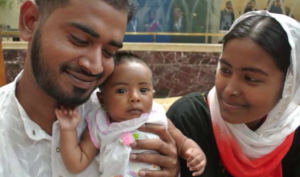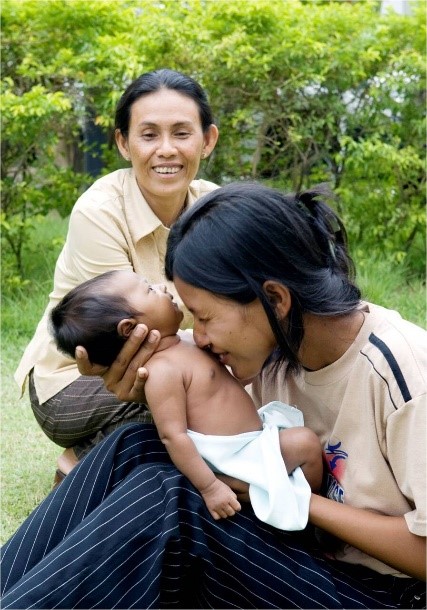Celebrating NeoNatalie, and the role she has played in helping save lives
We are proud to announce that the 100,000th NeoNatalie has been born! She has helped train health workers across the globe, from the labor rooms of Haydom Hospital in Tanzania to the skills labs in India. We are very appreciative of the team that came together to create her. She would not have been born had i t not been for the close collaboration between the Helping Babies Breathe group in the American Academy of Pediatrics (AAP) and the team at Laerdal. She would not have had the impact she has had, had it not been for the partners in the Helping Babies Breathe Global Development Alliance and the Survive and Thrive Global Development Alliance. Despite the urgent need to train more health workers in newborn resuscitation, we celebrate NeoNatalie’s success in the lives she has helped save so far.
How NeoNatalie was conceived
Shortly after the development of the MiniAnne inflatable CPR trainer in the early 2000s, the MiniBaby manikin followed. Made to be highly affordable, both manikins were used in the CPR Anytime programs in the U.S. by the American Heart Association (AHA) and the AAP.
In Jan 2008, at a AAP meeting on simplified approaches to training birth attendants in low resource settings, Tore Lærdal was invited to present MiniBaby and Laerdal’s educational training programs. The materials presented created great interest and formed the basis for the collaboration on the development of Helping Babies Breathe.
A team was formed at Laerdal to help modify MiniBaby and do the illustration of the training materials developed by AAP. The idea of filling the manikin with water for natural weight and a sloppy posture, as well as adding squeeze bulbs for crying, breathing and heartbeat, significantly enhanced realism of the manikin. This way, the low-cost manikin became a highly realistic simulator for the defined learning objectives of the program.
The development team worked closely with the experts through various iterations to fine-tune the manikin, from material composition to functionality, and in less time than normal gestation, NeoNatalie was born in 2008.
Impact of Helping Babies Breathe
Field testing  of the new simulator and training materials in India, Tanzania and Kenya showed very encouraging results. On that basis, USAID invited AAP, Laerdal, Save the Children and the National Institute of Health to form a Global Development Alliance to help widespread implementation of the program to address the problem of high newborn mortality due to birth asphyxia. A two-year impact study in Tanzania, with over 80,000 births, showed a 47% reduction in neonatal mortality and a 24% decrease in fresh stillbirths. A separate study in Nepal where HBB was implemented also showed significant improvements in outcomes, with over 63% decrease in both intrapartum stillbirth rate and first day mortality.
of the new simulator and training materials in India, Tanzania and Kenya showed very encouraging results. On that basis, USAID invited AAP, Laerdal, Save the Children and the National Institute of Health to form a Global Development Alliance to help widespread implementation of the program to address the problem of high newborn mortality due to birth asphyxia. A two-year impact study in Tanzania, with over 80,000 births, showed a 47% reduction in neonatal mortality and a 24% decrease in fresh stillbirths. A separate study in Nepal where HBB was implemented also showed significant improvements in outcomes, with over 63% decrease in both intrapartum stillbirth rate and first day mortality.
To bring the impact to l ife (quite literally), we recall a more personal experience from a mother who gave birth in a labour ward in Dhaka, Bangladesh. Rikta had a full term pregnancy with a normal delivery. In the presence of a birth attendant, she delivered within half an hour, but her baby girl was born not breathing. The birth attendant recalled that she had been trained in the Helping Babies Breathe program just two weeks before, so she knew what to do. After unsuccessfully attempting to revive the baby by stimulation, the birth attendant performed resuscitation using a bag and mask, followed by suction using the products she had been given at training. Within a minute, baby Taiyaba cried out.
ife (quite literally), we recall a more personal experience from a mother who gave birth in a labour ward in Dhaka, Bangladesh. Rikta had a full term pregnancy with a normal delivery. In the presence of a birth attendant, she delivered within half an hour, but her baby girl was born not breathing. The birth attendant recalled that she had been trained in the Helping Babies Breathe program just two weeks before, so she knew what to do. After unsuccessfully attempting to revive the baby by stimulation, the birth attendant performed resuscitation using a bag and mask, followed by suction using the products she had been given at training. Within a minute, baby Taiyaba cried out.
Taiyaba is one of many newborns who have been given a true chance to live with the help of a well-trained birth attendant. As of mid-2016, more than 80 countries have introduced Helping Babies Breathe. With 100,000 NeoNatalies out there it is safe to estimate that more than 400,000 people have been trained in newborn resuscitation, and thousands of lives have been saved.
